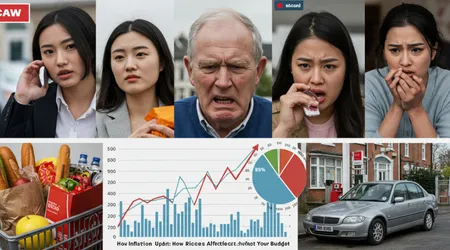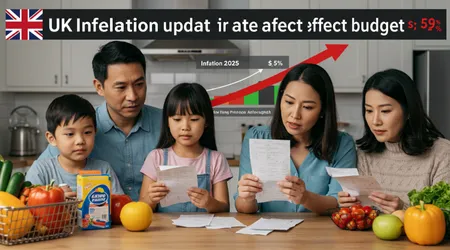UK Inflation Update June 2025: How Rising Prices Affect Your Budget

UK inflation update June 2025 reveals a persistent challenge for households grappling with escalating costs.
The Office for National Statistics (ONS) reported inflation at 3.5% in April 2025, the highest since January 2024, driven by surging household bills, including energy, water, and council tax.
This upward trend, expected to peak at 3.7% by September, signals tough times ahead for UK consumers. With prices climbing faster than anticipated, families face shrinking budgets and tough choices. How can you navigate this financial squeeze?
This article dives into the latest inflation data, its impact on your wallet, and practical strategies to stay afloat.
Inflation isn’t just a headline; it’s a daily reality eroding purchasing power. From grocery aisles to utility bills, the rising cost of essentials forces households to rethink spending.
The Bank of England’s cautious approach to interest rate cuts now at 4.25% after reductions in 2024 and 2025 reflects the delicate balance between curbing inflation and supporting growth.
Understanding these dynamics is crucial for anyone aiming to protect their finances. Let’s explore how UK inflation update June 2025 reshapes your budget and what you can do about it.
The Inflation Surge: What’s Driving It?
The UK inflation update June 2025 paints a stark picture. April’s 3.5% Consumer Prices Index (CPI) rise, up from 2.6% in March, caught analysts off guard.
Higher energy, water, and council tax bills fueled this spike, with services inflation a key Bank of England metric jumping to 5.4%.
These increases stem from structural changes, like the £25bn employer National Insurance Contributions (NICs) hike, which businesses pass onto consumers.
Food prices also contribute significantly. The British Retail Consortium reported food inflation at 2.8% in May, driven by soaring beef and fresh produce costs.
Imagine Sarah, a single mother in Manchester, who now spends £20 more weekly on groceries. This isn’t abstract economics it’s real money leaving real wallets.
The UK inflation update June 2025 underscores how these pressures ripple through daily life.
External factors, like US tariffs, add complexity. These trade barriers, recently imposed, raise import costs, potentially pushing prices higher.
For instance, a small business importing electronics faces steeper costs, which customers ultimately bear.
With the Bank of England forecasting inflation to linger above 3% through 2025, households must brace for sustained pressure.
++ Retirement in the UK: Strategies to Secure Your Financial Futur
Why does this feel like a treadmill you can’t step off? Each price hike forces a recalibration of priorities less dining out, fewer holidays.
The interplay of domestic policy and global trade dynamics creates a perfect storm. Families like Sarah’s are left juggling bills, wondering when relief will come.
The UK inflation update June 2025 suggests it won’t be soon.

How Inflation Hits Your Household Budget
Rising prices erode your income’s value, making every pound stretch less. The UK inflation update June 2025 highlights a 1.2% monthly price increase in April, driven by utilities.
For a family of four, this could mean an extra £150 annually on energy alone. Renters face steeper challenges, with private rents up 7.4% in April, squeezing budgets further.
Consider Tom, a London teacher, whose rent jumped from £1,200 to £1,288 monthly. His stagnant salary can’t keep pace, forcing him to cut subscriptions and weekend outings.
Core inflation, excluding volatile items like food and energy, rose to 3.8%, signaling broad-based price pressures. This isn’t just about luxuries it’s about basics like bread and heat.
Read more: How to Invest in ISAs: The Complete Beginner’s Guide for the UK
The psychological toll is real. Constantly reworking budgets breeds stress, as families weigh necessities against small joys.
The UK inflation update June 2025 shows no immediate respite, with forecasts suggesting inflation won’t hit the Bank of England’s 2% target until 2026.
For now, every purchase feels like a negotiation with your bank account.
This squeeze isn’t uniform. Lower-income households, spending a higher share on essentials, feel the pinch most acutely.
A 2025 ONS study found 60% of low-income families cut back on food to cover bills. The UK inflation update June 2025 demands smarter financial planning to mitigate these impacts.
Interest Rates and Borrowing: A Balancing Act
The Bank of England’s response to the UK inflation update June 2025 complicates borrowing.
With inflation at 3.5%, rate cuts expected in June or August are now likely delayed to September, keeping rates at 4.25%. Higher interest rates mean pricier mortgages and loans, hitting homeowners and small businesses hardest.
For example, a £200,000 mortgage now costs £1,200 monthly, up from £1,100 a year ago. This increase forces families to divert funds from savings or leisure.
Also read: Bank of England Cuts Rates: What It Means for British Finances in 2025
The Bank’s cautious stance, driven by services inflation at 5.4%, reflects fears of entrenched price rises. Yet, stalling rate cuts risks slowing economic growth, a dilemma for policymakers.
Savers, meanwhile, see mixed outcomes. Higher rates boost returns, but inflation outpaces most savings accounts, eroding real value.
The UK inflation update June 2025 suggests savers need high-yield options to stay ahead. Businesses, facing higher borrowing costs, may pause hiring, as seen with recent unemployment spikes.
This tightrope walk leaves consumers caught in the middle. Should you lock in a fixed-rate mortgage now or wait? The uncertainty fuels anxiety, as financial decisions grow riskier.
The UK inflation update June 2025 underscores the need for agility in navigating this high-rate environment.
Practical Strategies to Protect Your Finances
Facing the UK inflation update June 2025, proactive steps can shield your budget. First, scrutinize spending.
Track expenses for a month to identify cuts maybe swap branded groceries for supermarket own-labels, saving £10 weekly. Budgeting apps like Moneyhub can streamline this process.
Energy efficiency is another lever. Insulating your home or using a smart meter could cut bills by 10%, per Ofgem estimates.
For renters like Tom, negotiating rent increases or seeking cheaper areas is tough but viable. Switching energy providers before the July cap reduction could also yield savings.
Investing wisely counters inflation’s bite. Consider inflation-linked bonds or diversified funds to preserve wealth. For Sarah, putting £50 monthly into a low-cost index fund could grow over time, outpacing inflation.
Finally, boost income freelancing or upskilling can add a buffer. The UK inflation update June 2025 demands creative financial tactics.
Debt management is critical. Pay down high-interest credit cards first, as rates hover near 20%. Consolidating loans might lower monthly payments, freeing cash for essentials.
Community resources, like local food banks, can ease pressure for struggling households. Every small action counts in this high-cost era.
The Broader Economic Picture

The UK inflation update June 2025 reflects global and domestic pressures. US tariffs, as noted by Yahoo Finance, raise import costs, impacting prices from electronics to clothing.
Meanwhile, the IMF forecasts UK growth at 1.2% for 2025, but warns of slowdowns due to taxes and tariffs. This fragile recovery complicates inflation control.
Unemployment, now at a four-year high, signals businesses’ caution amid rising costs. The £25bn NICs hike, for instance, pushes firms to raise prices or cut jobs.
Like a car engine sputtering on low fuel, the economy struggles to gain momentum. Households feel this through tighter job markets and pricier goods.
Government policy adds another layer. Chancellor Rachel Reeves faces criticism for tax hikes, with opponents claiming they fuel inflation.
Yet, public spending cuts could deepen economic woes. The UK inflation update June 2025 highlights a need for balanced policies to avoid a recessionary spiral.
Businesses, too, adapt unevenly. Retailers like supermarkets pass on costs, while others, like electronics stores, offer discounts to spur demand.
This patchwork response creates unpredictable price swings, challenging consumers’ budgeting efforts. Staying informed and flexible is key to navigating this turbulent landscape.
Table: Key Inflation Metrics (April 2025)
| Metric | Value | Change from March 2025 |
|---|---|---|
| CPI Inflation | 3.5% | +0.9% |
| Core Inflation | 3.8% | +0.4% |
| Services Inflation | 5.4% | +0.7% |
| Food Inflation | 2.8% | +0.2% |
| Private Rent Increase | 7.4% | -0.3% |
Looking Ahead: What’s Next for Inflation?
The UK inflation update June 2025 offers cautious optimism. The Bank of England predicts inflation peaking at 3.7% this summer before easing to 2.2% by 2026.
Energy price caps, set to fall 7% in July, could provide relief, saving households £129 annually. However, persistent services inflation may delay rate cuts, prolonging high borrowing costs.
Global uncertainties, like US-China trade tensions, could exacerbate price pressures. If tariffs escalate, imported goods may cost more, hitting consumers harder.
For now, households must plan for inflation above 3% through 2025, adjusting budgets and expectations accordingly. Staying proactive is non-negotiable.
Policy decisions will shape the path forward. Will the government ease tax burdens to curb price rises? The answer hinges on political will and economic data.
For consumers, the focus remains on resilience cutting costs, boosting income, and investing wisely to weather the storm.
Conclusion: Navigating the Inflation Storm
The UK inflation update June 2025 signals a challenging road ahead, with prices squeezing budgets and testing resilience.
From Sarah’s grocery struggles to Tom’s rent hikes, inflation’s impact is deeply personal. Yet, by tracking expenses, optimizing energy use, and exploring income streams, you can regain control.
The Bank of England’s cautious rate strategy and global trade tensions add complexity, but informed choices make a difference.
This isn’t just about numbers it’s about your life, your choices, and your future. The 3.5% inflation rate, as reported by the ONS, demands action, not panic.
Like a ship steering through choppy waters, you can chart a course through this storm with savvy planning. Stay vigilant, adapt, and protect your financial future.
Frequently Asked Questions
1. Why is UK inflation rising in June 2025?
Inflation hit 3.5% in April due to higher energy, water, and council tax bills, plus increased business taxes and minimum wage hikes.
2. How can I protect my budget from inflation?
Track spending, switch to cheaper brands, improve energy efficiency, and consider inflation-linked investments to preserve purchasing power.
3. Will interest rates fall soon?
The Bank of England may delay cuts until September due to high services inflation, keeping rates at 4.25% for now.
4. How do US tariffs affect UK prices?
Tariffs raise import costs, increasing prices for goods like electronics and clothing, further fueling inflation.
5. When will inflation return to 2%?
The IMF and Bank of England forecast inflation nearing 2% by 2026, assuming no major global disruptions.
